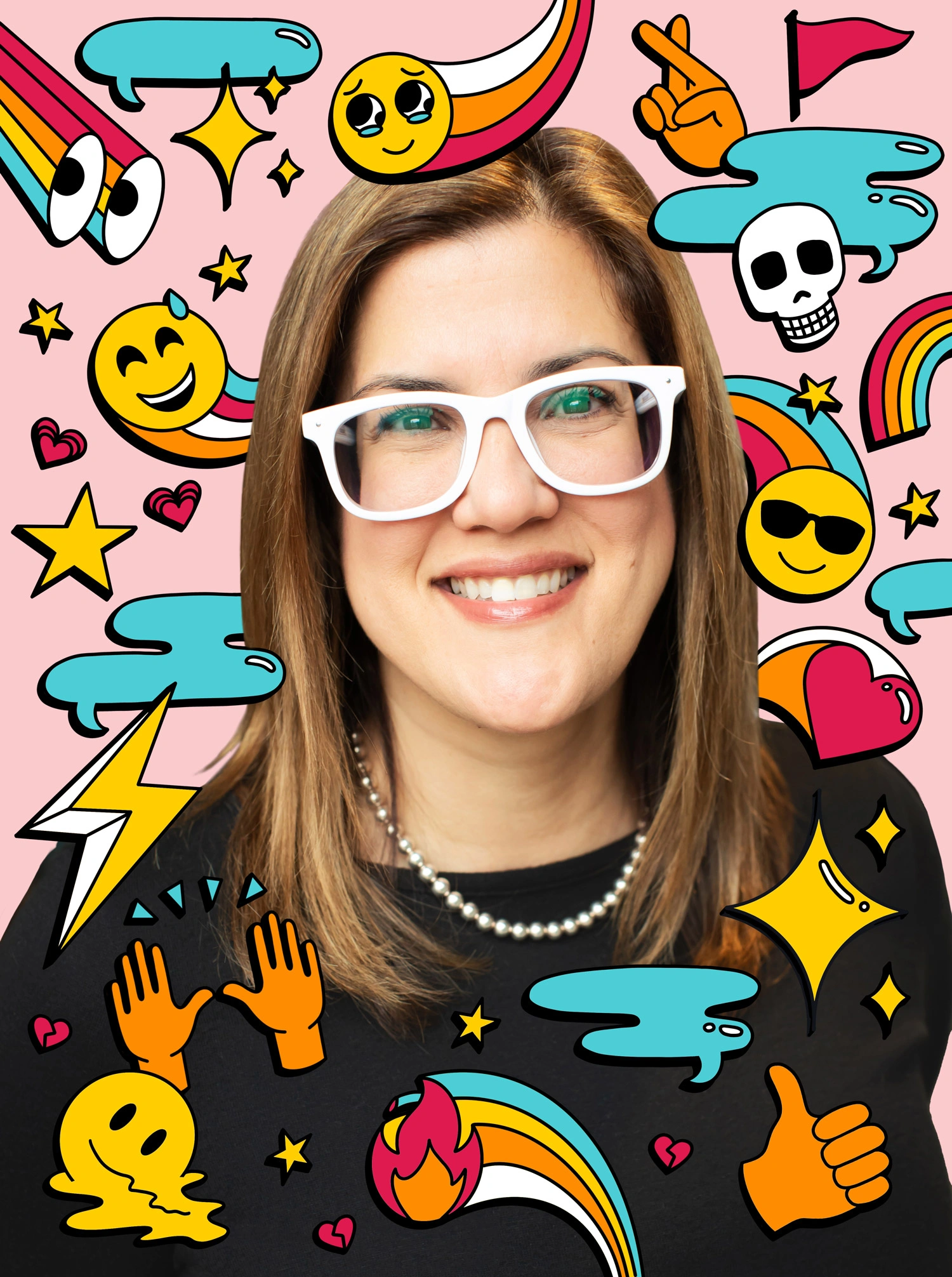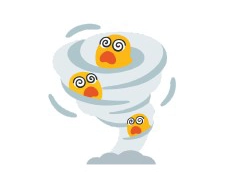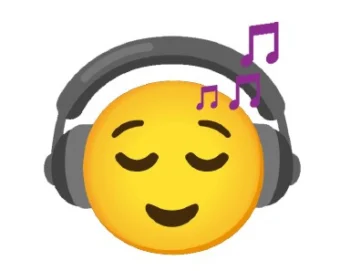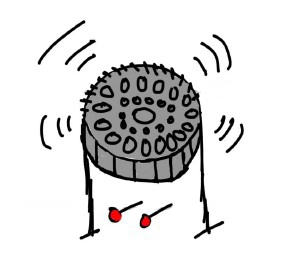
Are Emoji Becoming the World’s First Universal Language?
At U of T Mississauga, students are creating their own tiny icons for our phones. “Dizzy tornado face,” anyone? Read More
One day, in a class she teaches called Communication Among Cultures, Jordana Garbati, a writing professor at U of T Mississauga, noticed her students had suddenly become energized. They were talking about emoji – the little faces and icons people use to season their digital messages. “They were going on and on,” she says. Why do people make the emoji choices they do? How can the same simple image (a skull, say) mean completely different things to different people?
Garbati’s PhD is in education with a focus on applied linguistics, and it was from that angle that she began to wonder: Does this form of expression, lingua franca of millennials and Gen Z, have the potential to become a true universal language, an Esperanto for the digital age?
That joy she saw bubbling up in her undergrads – Garbati realized she’d seen it somewhere else, in someone who is not a digital native at all: her father. “His first language isn’t English – it’s Italian,” she says. “Sometimes he’ll string three or four emoji together, like a sentence, and expect the rest of us to understand. Often, I don’t have a clue, but my mom speaks Dad, so she’s often the translator.”
There is a saying: Where your own enthusiasm meets the world’s deep needs, that’s where you need to dig. Charged with a sense of possibility, Garbati quickly roughed out a proposal for an undergraduate class. Beginning this winter, the newly minted “Emoji Rhetoric: A New Paradigm in Communications” is being offered at U of T Mississauga.
If “emoji” is indeed a language – and the question of what deserves that designation will be lustily debated in the course – then it’s one with a far shorter history than most. The emoji we use today – to add nuance or irony, to take the sting off or pile emphasis on – emerged from two converging streams in the 1980s. The “emoticon” trend in America and the “kaomoji” trend in Japan (from kao for “face” and moji for “characters”) both featured the ingenious use of keystrokes to make – :0 – recognizable facial expressions. The actual little impish gestures and emblems we now call emoji began appearing on Japanese phones in the 1990s, and quickly spread across the world. “There are almost 4,000 emoji that are officially recognized,” Garbati says. You could do a lot with that many characters in your “alphabet.” You could probably communicate something meaningful.
There are almost 4,000 emoji that are officially recognized.”
Garbati reaches up and pulls down from her bookshelf a tome the size of a brick. It’s 720 pages long. The title: Emoji Dick. Moby Dick in emoji. “I’m not going to assign this – that might be cruel and unusual – but the person behind the project, Fred Benenson, is coming as a guest speaker,” Garbati says. “He’s in New York City so we’ll have him Zoom in.”
Surely, if there are enough tools in the chest to have a go at recreating a literary masterpiece, then most of the emoji we might reasonably need have already been invented, right?
Not exactly. Because emoji grew so quickly and helter-skelter, there remain significant holes in their coverage. New emoji are continually being pitched, and a multinational committee called the Unicode Consortium gives each candidate the thumbs up or thumbs down. Among the recent inductees: “exhausted face” and “leafless tree.”
Garbati is herself a (non-voting) member of the Unicode Consortium. By virtue of this lofty status, she is claiming the authority to act as a judge in one of the major assignments in her course: Propose your own emoji that the world needs right now.
Garbati is an educator and trained as an applied linguist, but this is actually a course in rhetoric, or persuasive communication. So, after coming up with their emoji, the students will make the case for why it should be included on every smartphone. Will everyone understand it? Can it cross cultural boundaries without much room for misinterpretation? Can it be used in a string – that is, would it make sense in a “sentence”? (Garbati briefly toyed with the idea of accepting presentations entirely in emoji. “But then I thought, what objective would that serve? You’re sacrificing a lot of range of expression.”)
In the event some student, maybe angling for extra credit, asks her what her emoji would be, Garbati has an answer: an icon of a stovetop espresso maker, an Italian coffee or moka pot. “I want that one because I talk about coffee a lot, I think about coffee a lot; it’s part of my heritage; it’s what I enjoy. And the existing coffee emoji (a utilitarian white cup and saucer) does not cover all the things coffee means. The question is whether there are enough people out there who resonate with what that little coffeemaker means to me.”
Musing about all the ways the course could go, Garbati quickly realized coming up with material wouldn’t be a problem. “I thought, I can take the language or linguistics perspective here, or the intercultural perspective. I’ll leave room in the course for students to explore emoji in a way they’re interested in, and tailor projects to their own area of focus – whether that’s anthropology or gender studies or business communication. Marketing students might delve into the universality: you can go into stores anywhere in the world and there’s likely going to be something sold with emoji. History students might want to trace emoji’s ancestry – you can go back pretty far. Hieroglyphics are early emoji, you could argue.”
Not long ago, it occurred to Garbati to try an experiment. In real life, we count on body language to make ourselves clear. In fact, words and gestures are so entwined that if you tie people’s hands behind their back while they’re speaking, they will sometimes speak differently, struggling for workarounds. What if, in the same vein, she placed a restriction on her students: today you can text all you want but you can’t use emoji. What would happen? Would their communication be hampered, or slowed? Would it invite the possibility of being misunderstood? Would they resort to making a phone call instead?
“I could see them worrying that everyone is mad at them because there were no happy-face emoji today!” Garbati says.
Science is a cruel mistress.
There should be an emoji for that.
“Emoji Rhetoric: A New Paradigm in Communications” is being offered at U of T Mississauga in Winter 2025. The second-year course is part of the Institute for the Study of University Pedagogy.
U of T Mississauga Students Create Their Own Emoji
From messy hair to the samosa, the newly proposed emoji capture emotions, culture and chaos
Students at U of T Mississauga aren’t just studying how emojis are used in texts and emails – they’re designing their own. In the class “Emoji Rhetoric: A New Paradigm in Communications,” taught by Prof. Jordana Garbati, 22 students pitched original emoji ideas, making their case in short essays for why their designs belong on every smartphone.
Garbati says she was impressed with the diversity and creativity of the proposals. “Students engaged with the course material about emoji rhetoric and demonstrated strong argument-writing skills,” she says, adding that the project wasn’t about artistic ability, but about persuading her why the emoji was needed and how it would be useful.
Here are a few of the original emoji students proposed:
“Dizzy tornado face,” by Ayesha Bholat
 Sometimes life feels like it’s spiraling out of control and words don’t cut it. Bholat proposes a dizzy tornado face emoji to capture that whirlwind feeling. Whether it’s work stress, school overload, or just one of those chaotic days, Bholat says her emoji would provide a quick and relatable way to express “I’m caught in a storm!”
Sometimes life feels like it’s spiraling out of control and words don’t cut it. Bholat proposes a dizzy tornado face emoji to capture that whirlwind feeling. Whether it’s work stress, school overload, or just one of those chaotic days, Bholat says her emoji would provide a quick and relatable way to express “I’m caught in a storm!”
“Listening to music,” by Adam Milcic
 Ever felt pure joy while listening to your favourite song? Milcic argues that this feeling deserves its own emoji. Despite music being a huge part of our lives, he observes that there’s no emoji to capture the act of listening to music and the happiness of enjoying a great tune. With music more accessible than ever through streaming, he believes this emoji would be a hit.
Ever felt pure joy while listening to your favourite song? Milcic argues that this feeling deserves its own emoji. Despite music being a huge part of our lives, he observes that there’s no emoji to capture the act of listening to music and the happiness of enjoying a great tune. With music more accessible than ever through streaming, he believes this emoji would be a hit.
“Samosa,” by Kaiden Rai
 The samosa is enjoyed worldwide, but there’s no emoji to represent it – an omission that Rai wants to fix. His samosa emoji would help celebrate South Asian culture, enhance food-related discussions, and offer a fun way to share the joy of this globally loved snack, he says. An emoji exists for dumplings, so why not for samosas?
The samosa is enjoyed worldwide, but there’s no emoji to represent it – an omission that Rai wants to fix. His samosa emoji would help celebrate South Asian culture, enhance food-related discussions, and offer a fun way to share the joy of this globally loved snack, he says. An emoji exists for dumplings, so why not for samosas?
“Messy hair,” by Sharleen Bains
 We’ve all been there – waking up with wild, untamed hair. Sharleen Bains thinks this common struggle deserves recognition. Her messy hair emoji would depict a flyaway mop and represent not just bad hair days, but also feelings of stress, disarray and exhaustion. It would be a universal symbol of the chaos we sometimes experience in our lives.
We’ve all been there – waking up with wild, untamed hair. Sharleen Bains thinks this common struggle deserves recognition. Her messy hair emoji would depict a flyaway mop and represent not just bad hair days, but also feelings of stress, disarray and exhaustion. It would be a universal symbol of the chaos we sometimes experience in our lives.
“Steelpan,” by Justin Abraham
 For many in the Caribbean, the steelpan is more than just an instrument – it’s a cultural symbol of celebration and resilience. Abraham argues that adding this emoji would not only celebrate Caribbean heritage but also enrich festival and music-related conversations. If Italy has a pizza emoji, and Germany has one for the accordion, why not the steelpan?
For many in the Caribbean, the steelpan is more than just an instrument – it’s a cultural symbol of celebration and resilience. Abraham argues that adding this emoji would not only celebrate Caribbean heritage but also enrich festival and music-related conversations. If Italy has a pizza emoji, and Germany has one for the accordion, why not the steelpan?
Although anyone can develop and submit a proposal to the Unicode Consortium, the global committee that approves emoji, students who want to have their emoji considered would have to follow the consortium’s guidelines. “The academic paper in our class took a different approach,” says Garbati.
For many students, the assignment yielded its own rewards. Justin Abraham, the creator of the steelpan emoji, says he gained a deeper understanding of how emoji enhance digital communications, and enjoyed being able to “advocate for Caribbean heritage through an underrepresented musical symbol.”
Sharleen Bains, a third-year student in life sciences, says she found it challenging to think of an emoji that didn’t already exist. The assignment got easier when she landed on the messy hair idea and reflected on her own perceptions about hair and global beauty standards. She adds that as a science student, she doesn’t often do this kind of assignment. “It was a nice way to get in touch with my creative side.”
Which of the students’ emoji would you use? Let us know in the comments – or suggest your own!
Decoding Emoji Dick
A whale of a tale in tiny icons
Professor Jordana Garbati isn’t expecting her students to read all 700-plus pages of it – she hasn’t even done so herself – but the book Emoji Dick will be on the syllabus for her new winter-term class “Emoji Rhetoric: a New Paradigm in Communications.”
Emoji Dick. That’s Moby Dick translated into emoji. A literary artifact so, well, novel that the U.S. Library of Congress snapped it up for their collection in 2014.
Value added for Garbati’s students: its author, Fred Benenson, will attend a class via Zoom.
“I invited him because he seems intriguing, and honestly, the book is unlike anything I’d seen,” says Garbati. “We’ll look at a few pages of text and discuss the translation of the words to emoji.”
Benenson’s process here was unique, to say the least. He crowdsourced every sentence on the Internet – with the highest-voted emoji “translation” making the cut. “The translations aren’t direct,” Garbati says. “I imagine that if I gave the word sentences to students and asked them to translate using emoji, there would be a lot of different submissions. For example, emoji for the sentence, ‘I thought I was speaking to the Captain himself’ include a heart and a pasta. Why?”
Garbati adds that she is curious about Benenson’s perspective generally on emoji and language. He comes out of the tech world, where he’s a bit of a rock star (employee number two at Kickstarter), rather than linguistics. “And I know Fred has created at least one emoji himself that has been adopted by the Unicode Consortium, so it’ll be interesting to get his take on that.”






No Responses to “ Are Emoji Becoming the World’s First Universal Language? ”
Such an interesting course! Congratulations to Prof. Jordana Garbati, and thanks to Bruce Grierson for the article.
Messy Hair and Dizzy Tornado Face would be my suggestions.